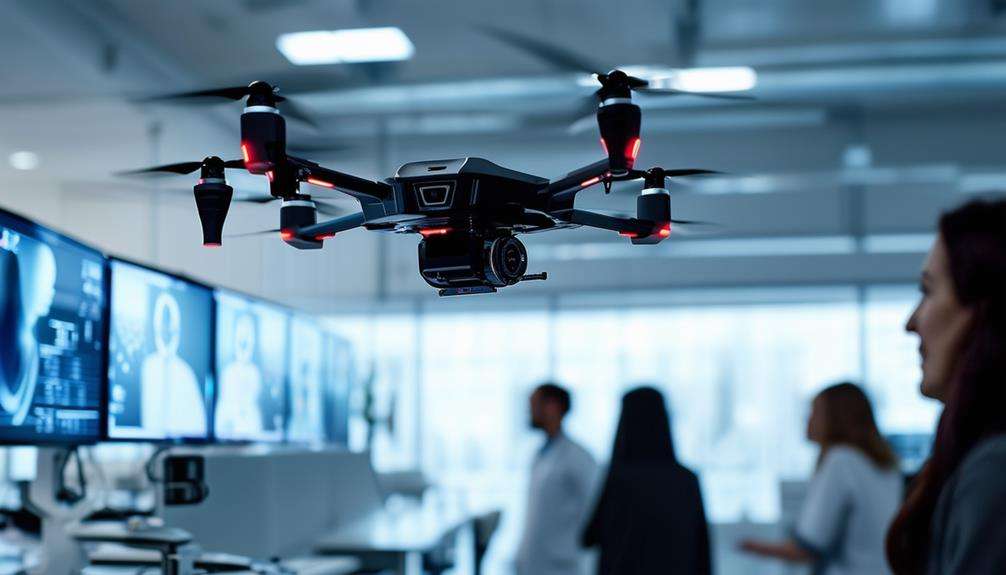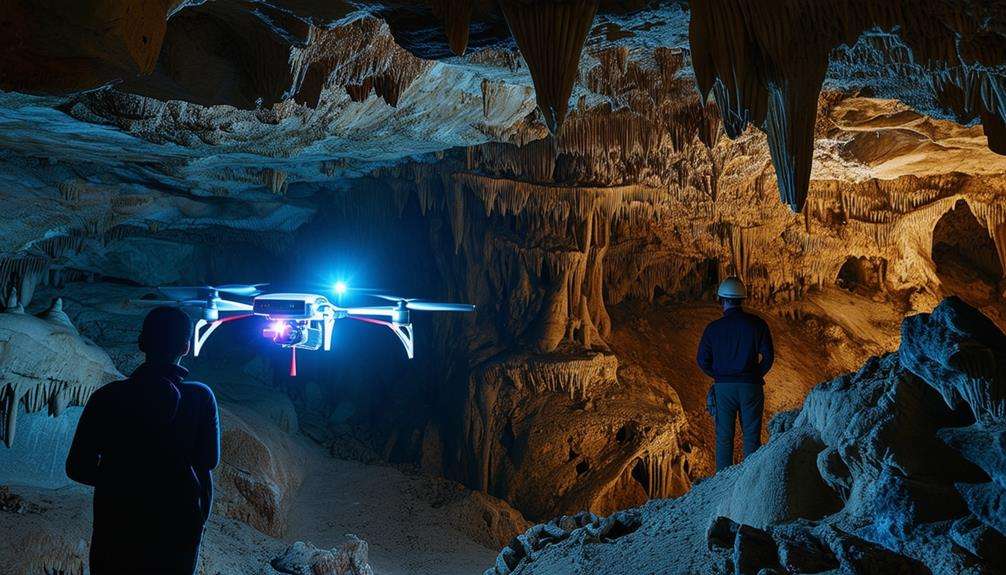How Far Can a Delivery Drone Fly?
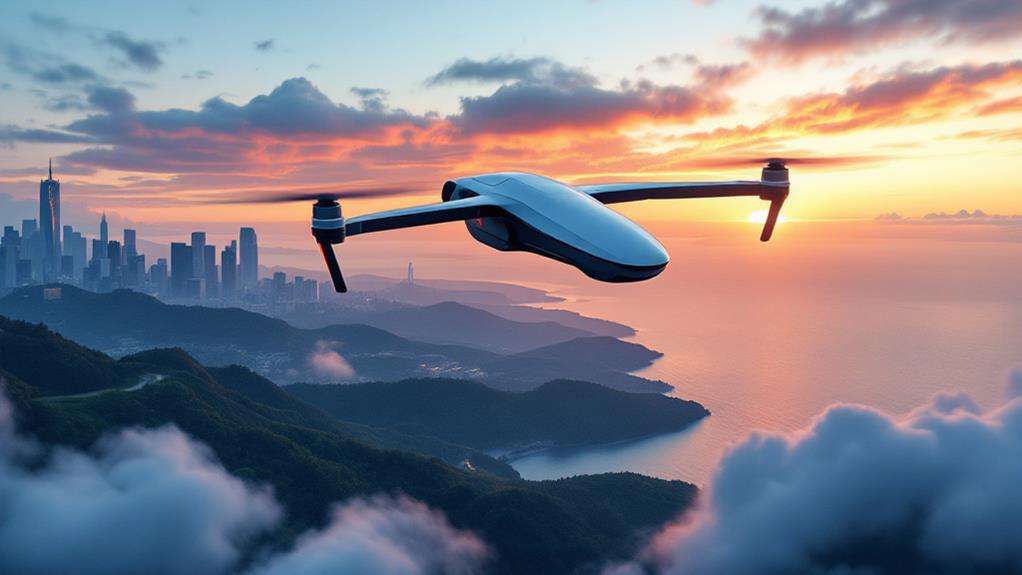
Delivery drones typically fly between 10 and over 50 miles. The range depends on several factors including battery capacity, payload weight, and environmental conditions. Heavier payloads and poor weather can shrink their reach, while efficient design and favorable settings can extend it. Most drones carry between 5 to 20 pounds and face regulatory limits like staying within a pilot's line of sight. Advanced models, such as those used for medical deliveries, push past 50 miles. Technological advancements in battery, navigation, and communication systems promise even greater distances. Discover how technology is shaping the future of drone delivery.
Key Takeaways
- Delivery drones typically have a range of 10 to 50 miles, with advanced models exceeding 50 miles.
- Payload weight affects range; lighter payloads can extend flight beyond 15 miles.
- Weather conditions like wind and precipitation can significantly reduce effective range.
- FAA regulations require VLOS operation; BVLOS needs special exemptions, impacting range.
- Advances in battery technology and motor efficiency continue to improve drone range capabilities.
Factors Influencing Drone Range
When it comes to understanding how far delivery drones can fly, several factors significantly influence their range. First and foremost, the maximum drone delivery range is typically around 10 miles. This distance is largely determined by battery capacity. Larger batteries can power drones for longer flights, but they also add weight, which can compromise efficiency. You need to balance battery size with weight to optimize the range. Additionally, advanced obstacle avoidance systems play a crucial role in urban environments, ensuring drones can navigate safely, potentially impacting their flight path and overall distance.
Environmental conditions are another key factor. Wind speed and temperature can drastically impact how far a drone can travel. Headwinds can shorten the range, making it harder for the drone to cover the intended distance. Conversely, tailwinds might extend the drone's reach, helping it to conserve energy.
The drone's design and weight also play crucial roles. Streamlined designs can improve efficiency, allowing drones to fly further without expending extra energy. However, heavier drones require more power, which can reduce their range. Efficient brushless motors and well-designed propellers are essential to minimize energy consumption. By focusing on these components, you can enhance the operational range of delivery drones, ensuring they cover more ground with less energy. Balancing these factors is key to maximizing drone delivery range.
Current Drone Flight Capabilities
In the realm of current drone flight capabilities, delivery drones have impressively expanded their reach and efficiency. Today's delivery drones can typically cover a distance of about 10 miles, making them an excellent choice for quick, short-range deliveries. These drones can carry up to 20 pounds, which suits a variety of delivery needs, from consumer goods to essential supplies. With operational speeds reaching up to 200 mph, they offer rapid transportation over these distances, significantly cutting down the time it takes to get items to their destination. Thanks to innovations in UAV design, the drones are becoming more efficient and capable, which is crucial given the anticipated transformative shift in global package delivery.
Drone technology advances have led to remarkable improvements in delivery drone performance. For instance, some advanced models, like those used by companies such as Ziplines, can exceed the standard range, flying over 50 miles. These drones are particularly valuable for delivering medical supplies to remote or hard-to-reach areas. Factors like battery capacity, payload weight, environmental conditions, and flying style can influence their operational range. As a user, understanding these aspects helps you appreciate the capabilities and limitations of delivery drones today. With continuous improvements in technology, the future promises even greater reach and efficiency for these remarkable machines.
Regulatory Limits on Drone Range
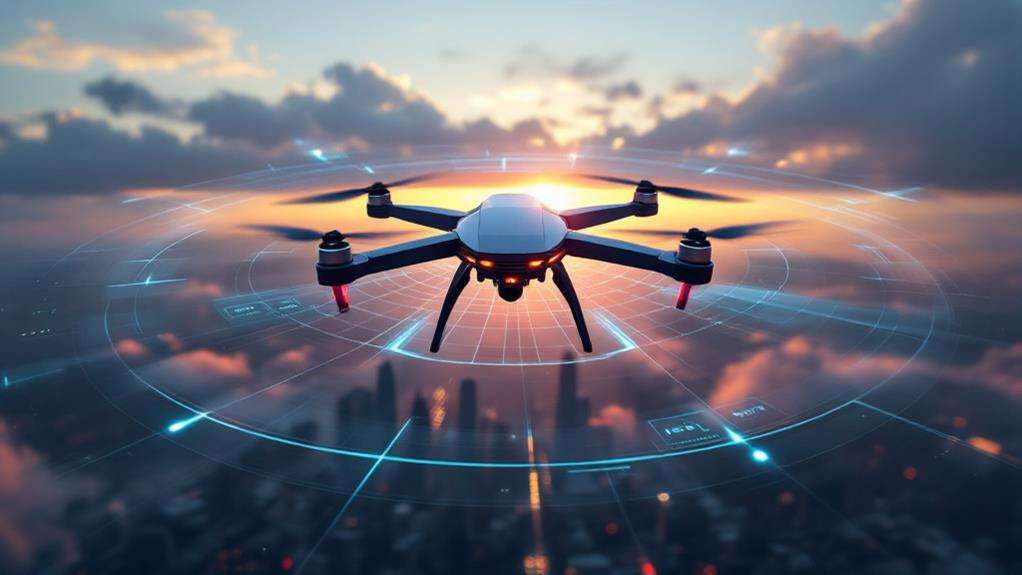
Despite the impressive technological capabilities of delivery drones, regulatory constraints often dictate their operational limits. You might assume a drone could simply fly as far as its battery allows, but rules say otherwise. The Federal Aviation Administration (FAA) requires that drones operate within the pilot's visual line of sight (VLOS), which significantly restricts their range. If you're looking to venture into Beyond Visual Line of Sight (BVLOS) operations, you'll need special exemptions from the FAA. These exemptions involve a lengthy and detailed application process, making it a challenge to expand drone deliveries efficiently.
Local regulations add another layer of complexity. Different jurisdictions might impose their own restrictions on how far a drone can fly, creating a patchwork of rules that can be difficult to navigate. This cumulative effect of federal, state, and local regulations poses significant barriers to widespread drone delivery services.
Here's a quick look at the regulatory framework:
| Regulation Level | Impact on Drone Range |
|---|---|
| Federal (FAA) | Limits to VLOS, BVLOS needs exemptions |
| State | Varies, adds potential restrictions |
| Local | Potential additional constraints |
Navigating these regulations is crucial for successful drone delivery operations.
Advances in Drone Technology
While regulatory constraints present significant challenges, technology is rapidly evolving to push the boundaries of delivery drone capabilities. You're witnessing remarkable advances in drone technology that promise to extend the range of delivery drones well beyond the current limit of 10 miles. High-energy-density batteries are at the forefront of this evolution, allowing drones to fly longer without adding much weight. This innovation is crucial for enhancing flight duration and efficiency.
In addition, the integration of enhanced signal strength and communication systems, like cellular networks and satellite communication, is enabling drones to operate over greater distances. These improvements ensure that drones maintain a strong connection even when flying far from their base.
Moreover, efficient motor designs and advanced propeller aerodynamics are reducing power consumption, which directly impacts the range of delivery drones. By optimizing energy use, drones can travel further without needing frequent recharges.
Impact of Weather on Range
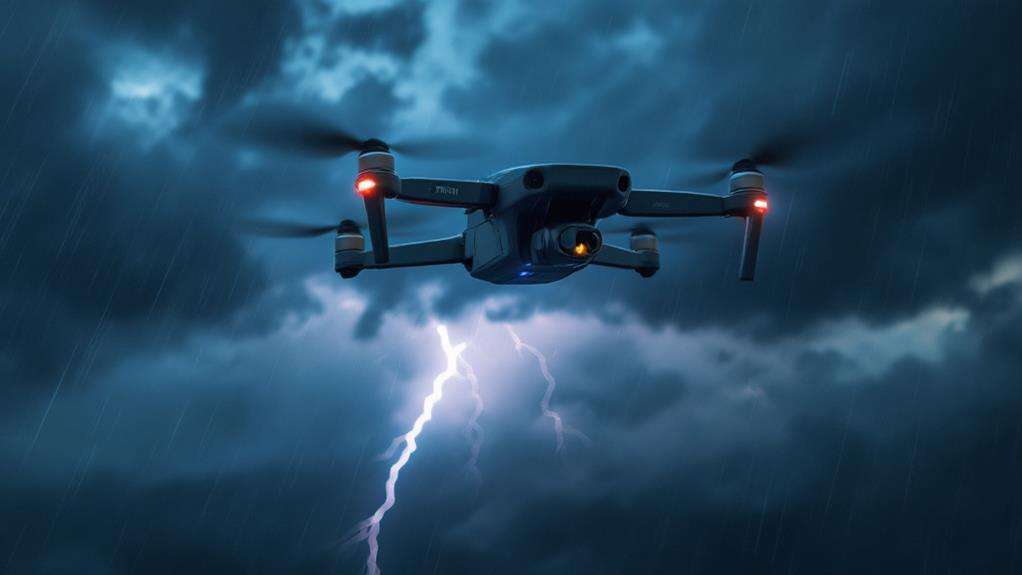
Though technology is advancing rapidly, weather conditions still play a crucial role in determining how far a delivery drone can fly. For drone delivery and commercial operations, understanding these factors is vital. Strong winds, for instance, can significantly reduce a drone's effective range. While headwinds increase energy consumption, tailwinds might actually help by boosting range. However, relying on the whims of the wind isn't practical for precise commercial operations.
Rain and snow add another layer of complexity by increasing weight and altering aerodynamics, which can limit how far drones fly. You'll notice that temperature extremes also have an impact. Cold weather tends to sap battery efficiency, cutting down flight time more than you might expect. It's not just the cold; high humidity levels can increase drag, further reducing the drone's range.
Additionally, severe weather conditions like thunderstorms pose serious risks. Drones must steer clear of these, often leading to flight cancellations or diversions, which can disrupt delivery schedules. In summary, while technology is pushing boundaries, weather remains a critical consideration for optimizing drone delivery in commercial operations. Navigating these challenges ensures drones can deliver efficiently, no matter the forecast.
Energy Efficiency and Battery Life
Energy efficiency and battery life are pivotal in determining how far a delivery drone can venture. You might wonder how these factors come into play. Well, the battery capacity is key—larger batteries allow longer flights, but they also add weight, which can compromise energy efficiency. Delivery drones typically boast a maximum range between 10 to 50 miles, largely dependent on their design and how efficiently they use their batteries.
Technological advancements are on your side, though. High-energy-density batteries have significantly improved flight durations without adding much weight. This means you can expect drones that fly farther without the burden of heavier batteries. But it's not just about the batteries. Efficient brushless motors and well-designed propellers are essential in minimizing energy consumption. These features help you get the most out of each charge, extending the drone's range.
Role of Payload in Distance
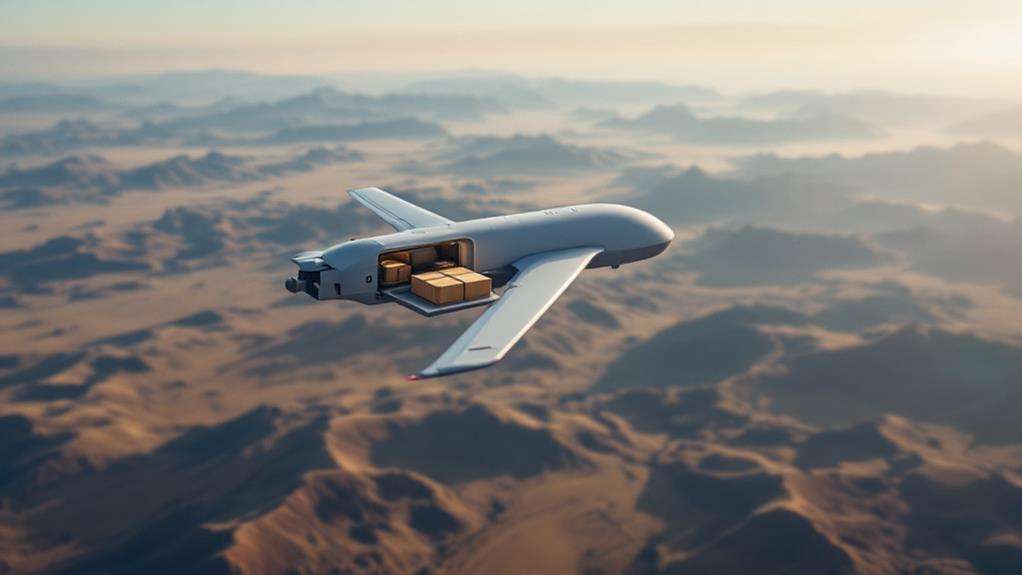
Payload plays a crucial role in determining how far a delivery drone can fly. When you're planning drone operations, the weight of your payload delivery is a key factor. Most delivery drones can carry between 5 to 20 pounds, but as the payload gets heavier, the drone's power consumption increases. This means a heavier load can significantly reduce the drone's battery life, limiting its range.
For instance, if your delivery drone is maxed out on its payload capacity, it might only reach 10 miles. On the other hand, with a lighter payload, the same drone could extend its range to 15 miles or more. The drone's design efficiency, including its motors and aerodynamics, also impacts how effectively it can manage a specific payload weight.
Balancing the payload weight with the drone's battery capacity is essential in optimizing flight duration and delivery efficiency. If you exceed the optimal payload limits, you might find yourself facing shorter flight times and less efficient deliveries. So, careful planning of your payload delivery ensures you're making the most of your drone's capabilities, allowing for efficient and effective drone operations.
BVLOS Operations and Challenges
BVLOS operations represent a significant leap forward for delivery drones, allowing them to travel far beyond the typical visual line of sight limitations. When you're dealing with drones, this means they can navigate and deliver packages over much greater distances. Normally, drones are limited to about 0.25 to 0.5 miles for recreational use, but BVLOS opens up a whole new world. However, to operate beyond visual line of sight, the FAA requires a Section 44807 exemption. This isn't a simple process. You're looking at a lengthy approval involving extensive paperwork and rigorous safety assessments to ensure compliance and public safety.
Advanced onboard detect-and-avoid technology is crucial for BVLOS operations. This tech helps drones safely navigate around airborne obstacles like airplanes and helicopters, which is vital for long-distance flights. With successful BVLOS approvals, the typical 10-mile range limitation for delivery drones can be significantly extended, making delivery systems more efficient. However, regulatory challenges persist. Varying local laws and complex compliance requirements present obstacles for companies wanting to implement these operations. Navigating these regulations can be daunting, but overcoming these challenges is key to unlocking the full potential of BVLOS delivery drones.
Extending Drone Flight Distance
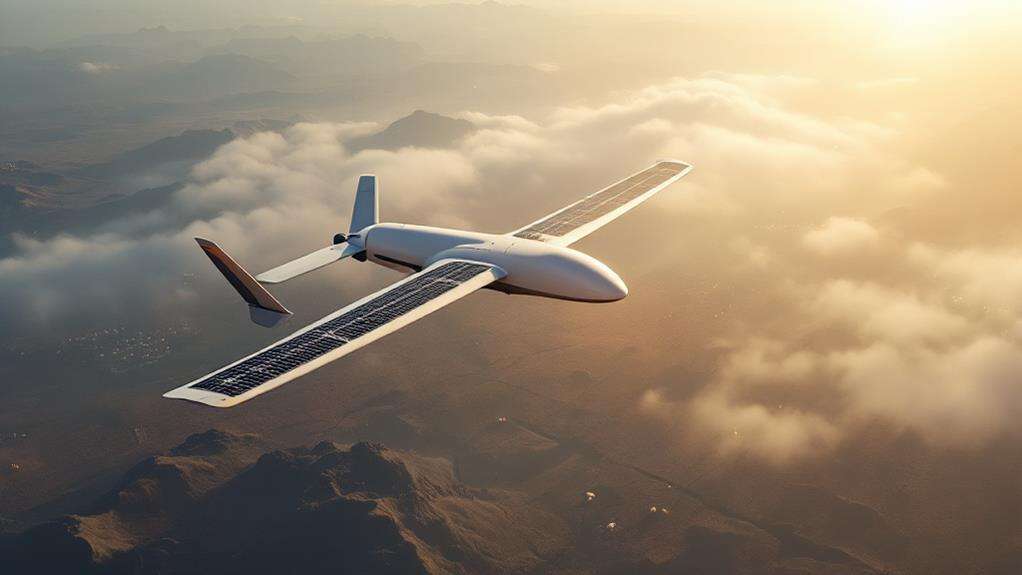
Many factors can influence how far a delivery drone can travel, but exciting advancements are reshaping these limits. Typically, delivery drones have an operational range of 10 to 50 miles, heavily dependent on design and battery capacity. However, cutting-edge models, like those from Zipline, are pushing past these boundaries, especially in delivering essential medical supplies over 50 miles.
If you're a drone pilot, you know that battery life, environmental conditions, and payload weight are crucial in determining how far your drone can fly. These elements can either enhance or restrict a drone's efficiency and range. Innovations in battery technology and motor efficiency offer hope for longer flights. By improving energy storage without adding extra weight, drones can cover greater distances.
Regulatory frameworks, such as FAA guidelines, add another layer of complexity. Many delivery drones are required to stay within the visual line of sight, limiting their potential range. As a drone pilot, understanding these regulations is vital as they dictate your operational limits. By staying informed and adapting to new technologies, you can maximize your drone's delivery capabilities and push the boundaries of what's possible.
Future Prospects for Drone Range
As technology advances, the future prospects for extending drone range look promising. You're likely to see significant increases in delivery drone range, thanks to breakthroughs in battery technology. Enhancements in energy density mean drones can fly longer without getting heavier, pushing boundaries from the typical 10-mile range to potentially 50 miles or more. This leap could revolutionize how you receive packages, especially in remote areas.
Incorporating advanced communication systems like 4G/5G and satellite technology will support drones in covering greater distances effectively. You'll find that robust communication helps maintain reliable connections, ensuring that drones follow their intended paths without interruptions. Moreover, these systems are crucial for navigating complex terrains and urban environments safely.
The integration of cutting-edge motor and propeller designs also plays a vital role. By improving energy efficiency, drones can extend their range while still carrying the loads you need delivered. It's not just about flying further; it's about doing so efficiently and safely.
Lastly, advancements in autonomous navigation and obstacle avoidance systems mean drones can confidently tackle more complex routes. This ensures that your package arrives safely and promptly, even if it involves a longer journey.


